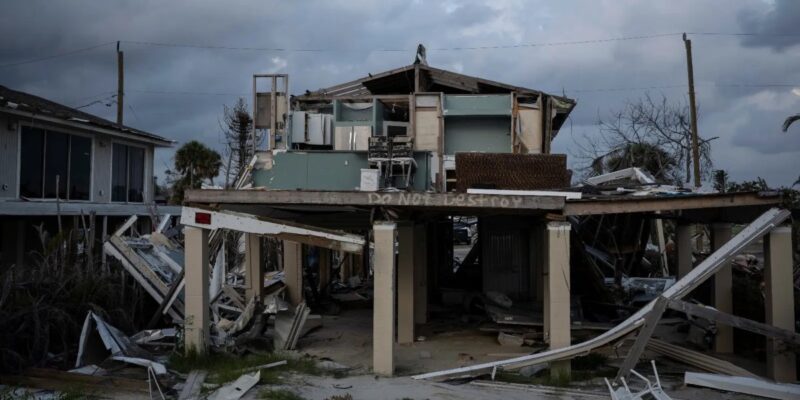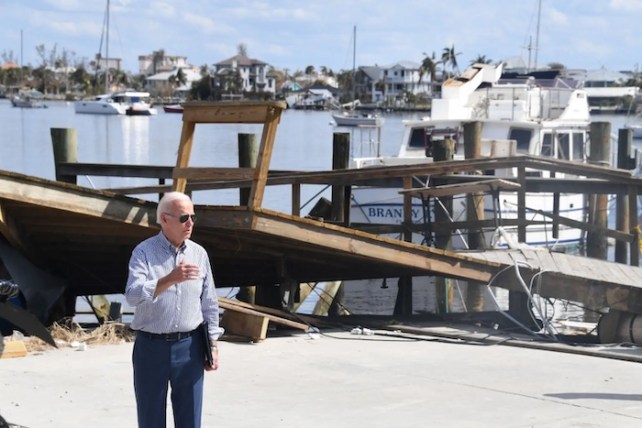
This story was originally published by Grist and is reproduced here as part of the Climate Desk collaboration.
When US homeowners buy subsidized flood insurance from the Federal Emergency Management Agency, they make a commitment to build back better after flood disasters, even if it costs them. FEMA’s notorious 50 percent rule stipulates that if a home in a flood zone suffers damages worth more than half its value, it must be torn down and rebuilt so it’s elevated above flood level. This can cost homeowners hundreds of thousands of dollars, but it prevents the American public from footing the bill for the repeated destruction of vulnerable homes—at least in theory.
Enforcement of the 50 percent rule largely falls to local officials in flood-damaged regions, who are charged with ensuring that their constituents aren’t rebuilding in flood zones. In exchange for this diligence, the federal government subsidizes low-cost flood insurance for homes in communities that certify their compliance with the rule, goosing red hot real estate markets in Florida and other scenic but climate-threatened regions.
As Florida continues rebuilding from 2022’s devastating Hurricane Ian, however, the Biden administration may be signaling that this era of easy money is over. Late last month, FEMA sent an explosive letter to local officials in Lee County, Florida, where over 750,000 people live near some of South Florida’s most prized coastal land. FEMA claimed that almost 600 homeowners in the city of Cape Coral and other nearby towns had rebuilt vulnerable homes in the flood zone over the 18 months since Hurricane Ian, violating the 50 percent rule as well as local construction laws.
The agency had long given the county and its cities a 25 percent discount on flood insurance in recognition of the county’s efforts to control flood risk, which saved residents millions of dollars a year. The letter threatened to yank away that discount, arguing that the county’s lax approach to the Hurricane Ian rebuild had negated those earlier efforts. The message was clear: After decades of risky construction in floodplains, the feds were putting their foot down.
This new effort to penalize floodplain construction is yet another sign that the long-hidden costs of climate change and development are starting to catch up with homeowners in coastal states—and at the very same time that housing costs more broadly are increasing for many Americans. FEMA has already raised flood insurance premiums across the country in recent years to keep up with mounting risk, and private home insurance companies have also hiked premiums for wind insurance in several states along the Gulf Coast.
The crackdown in Lee County represents an attempt by FEMA to shift the cost burden of climate risk away from the federal government (and the public that funds it) and onto local homeowners. This will test the strength of the area’s white-hot real estate market, potentially forcing many homeowners to walk away from their waterfront properties. As the federal government and private insurers both try to reduce their exposure to climate change, Lee County and its cities could be canaries in the coal mine for a housing market disfigured by mounting flood risk.
The reaction from these canaries has been swift and furious. Elected leaders from the county and the city blasted FEMA as “villains” and accused the agency of hampering Florida’s hurricane recovery at the behest of President Joe Biden. Lee County’s board of commissioners mulled suing the agency at a tense meeting a few days after the announcement. Local TV stations ran dozens of stories about the impact FEMA’s decision would have on homeowners, who are already dealing with a steep rise in both flood insurance and traditional property insurance, which covers wind damage.
“It’s almost like revenge politics,” said Cecil Pendergrass, a Lee County commissioner, during the county meeting after the announcement. “Our citizens, our taxpayers are being held hostage here.”
FEMA soon put its decision on pause, giving the county an extra 30 days to prove it hadn’t let homeowners break the 50 percent rule or build in the floodplain. It is unclear whether Lee County or cities like Cape Coral will be able to do that. Federal and local officials declined to provide Grist with details about the post-Ian violations, citing privacy concerns, but if homeowners have already rebuilt their destroyed properties, the county won’t be able to fix that within a month.
The bigger question for communities around the country is whether FEMA is changing how it enforces the 50 percent rule in an effort to force homeowners out of flood-prone areas.
“The floodplain management community is tracking this very closely,” said Susanna Pho, the founder of a flood risk firm called Forerunner, which helps flood-prone communities with FEMA compliance.
Lee County has long been a poster child for risky waterfront development. The city of Cape Coral sits on artificial filled land in what used to be a swampy section of Florida shoreline, with no barrier between the city’s urban landscape and the Gulf of Mexico. When hurricanes strike, as Ian did in 2022, they can push as much as 15 feet of storm surge through the city, inundating thousands of homes. Nearby cities such as Bonita Springs, which also caught a penalty from FEMA, aren’t much safer.
The 50 percent rule is supposed to reduce this risk over time by ensuring that flood-prone homeowners don’t rebuild the same vulnerable properties over and over. If a county determines that a home has suffered what FEMA calls “substantial damage,” it must force the homeowner to tear it down and elevate a new home above flood level, often on concrete pilings. If a county doesn’t comply, FEMA can kick it out of the federal flood insurance program, rendering homes more or less uninsurable, or downgrade its discounts as it did with Lee County. This rule acts as a de facto tax on risky property: Flood insurance payouts max out at $250,000 per home, which means homeowners are often on the hook for tearing down their houses and building new ones.
The problem is that determining what counts as “substantial damage” is a complicated process. Local officials conduct basic “windshield assessments” in the first few weeks after a storm, logging damage information that they can see from the street as they clear debris. They only do detailed examinations for the 50 percent rule when homeowners request permits to rebuild. But many homeowners never request permits from their city or county. Instead, they come back and patch up homes that they should be tearing down and rebuilding at higher elevations, and the local government either never catches them or looks the other way.

President Biden visits Fort Myers, Florida, after 2022’s Hurricane Ian.
Olivier Douliery/AFP/Getty/Grist
This mandate puts local governments in a tough political situation: They have FEMA on one side, urging them to enforce strict flood rules, and displaced homeowners on the other side, trying to get back in their homes without going broke. It’s unclear how much Lee County and its cities knew about the hundreds of rebuilt homes that FEMA alleges were noncompliant after Ian, but attempts to flout the 50 percent rule have been a scourge for the agency going back decades.
Albert Slap, a coastal planning consultant in Florida, said he understood why Lee County or cities like Cape Coral might have allowed homeowners to repair their homes without elevating.
“It’s pretty clear that the motivation is voters,” he said. “The people who got damaged are voters, and they’re going, ‘If you make me build back better, I’m not gonna be able to do it, and I’m leaving. I voted you guys into office and you’re screwing me.’”
Lee County says it followed normal protocol after Hurricane Ian, conducting basic damage assessments in the immediate aftermath of the storm and inspecting homes only later on when homeowners requested permits. Flood and disaster experts who spoke to Grist said this protocol is more or less standard across Florida and other hurricane-prone states, which raises the question of whether FEMA is changing the way it enforces the 50 percent rule and cracking down harder on rogue rebuilds.
FEMA didn’t answer questions about its enforcement strategy. In response to questions from Grist, a spokesperson said the agency is “committed to helping communities take appropriate remediation actions” to fix the rebuild violations. A spokesperson for Lee County said the county “will work with its partners at FEMA during a 30-day extension period.”
Adam Botana, a Republican state representative whose district encompasses much of Lee County, said he had faith that Lee County and other local governments would address the violations that FEMA identified and take action against homeowners who rebuilt without following FEMA regulations.
“Nobody likes the 50 percent rule, but I understand there have to be rules,” he told Grist. “Some municipalities may be a little more lax than others, but we have to keep everybody in line.” He added that he thinks the county will be able to prove many of the alleged violations didn’t take place.
Even if Lee County manages to contest the decision, homeowners in Southwest Florida are almost guaranteed to suffer more financial pain as a result of this enforcement effort. If FEMA stays the course and removes the discount, it will raise flood insurance costs for homeowners in unincorporated parts of the county between $14 and $17 million per year, equating to a $300 annual hit for each flood insurance customer in the area. But if Lee County cracks down on the 50 percent rule and FEMA restores the discount, homeowners who rebuilt in flood zones may have to spend hundreds of thousands of dollars to elevate their homes.
This new penalty comes on top of a much larger rate hike that FEMA has rolled out over the past few years as part of an effort to fix issues with the flood insurance program. This new system, called Risk Rating 2.0, will triple insurance costs in Lee County by the time it takes full effect, raising the average annual premium from around $1,300 to almost $4,000, with some of the most extreme bills ballooning well over $10,000 per year. Florida’s private insurance market for wind damage is also in a tailspin: More than 30 private carriers have pulled back from the state over the past two years, thanks in part to mounting hurricane risk. Those that have stuck around have doubled or tripled their prices.
Lisa Miller, a veteran Florida political consultant and former state insurance regulator, said the burden of rising costs shouldn’t trump the need to ensure that Lee County homes are resilient to future disasters.
“When I hear someone tell me they don’t want to pay $12,000 a year, I remind them: ‘We live in Florida,’” she said. “Our catastrophe risk is higher than almost anywhere in the world. What matters is, the homes that were repaired when they should have been torn down and rebuilt—will they withstand the next storm? That’s the question.”















